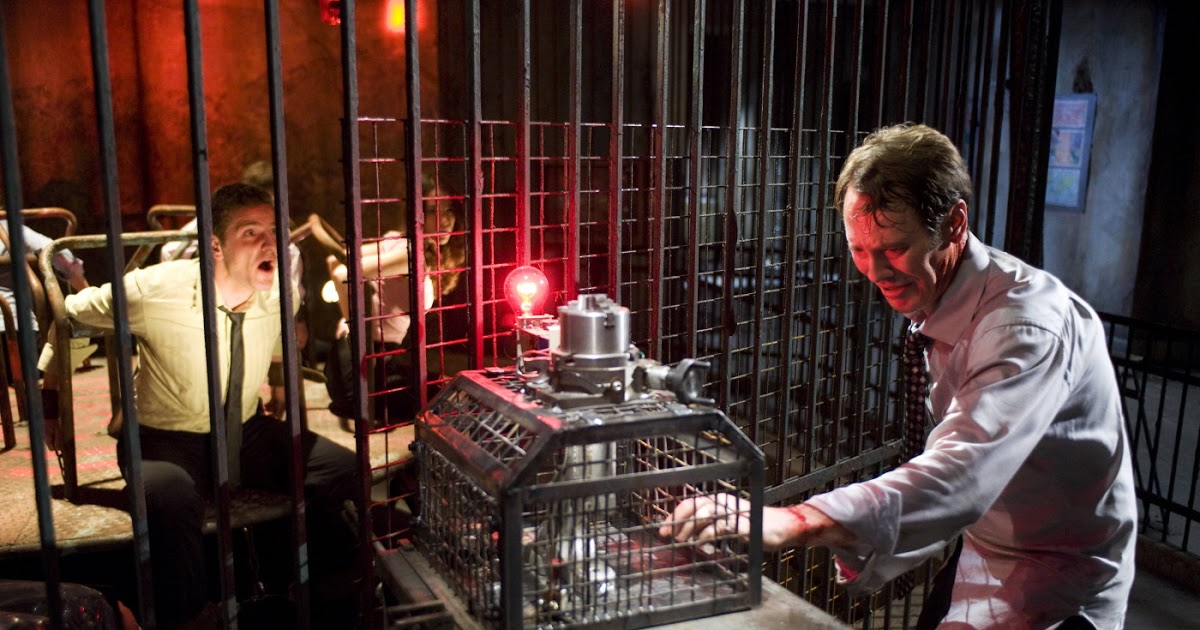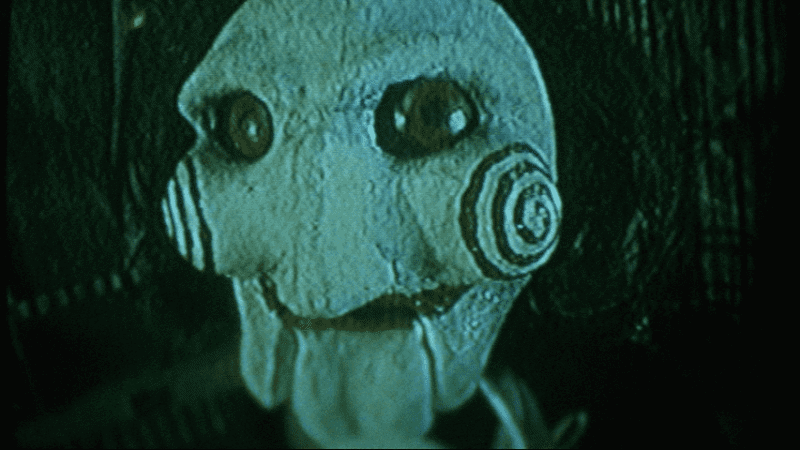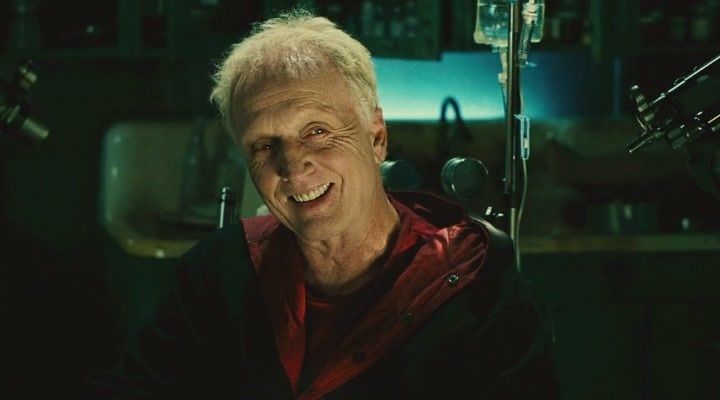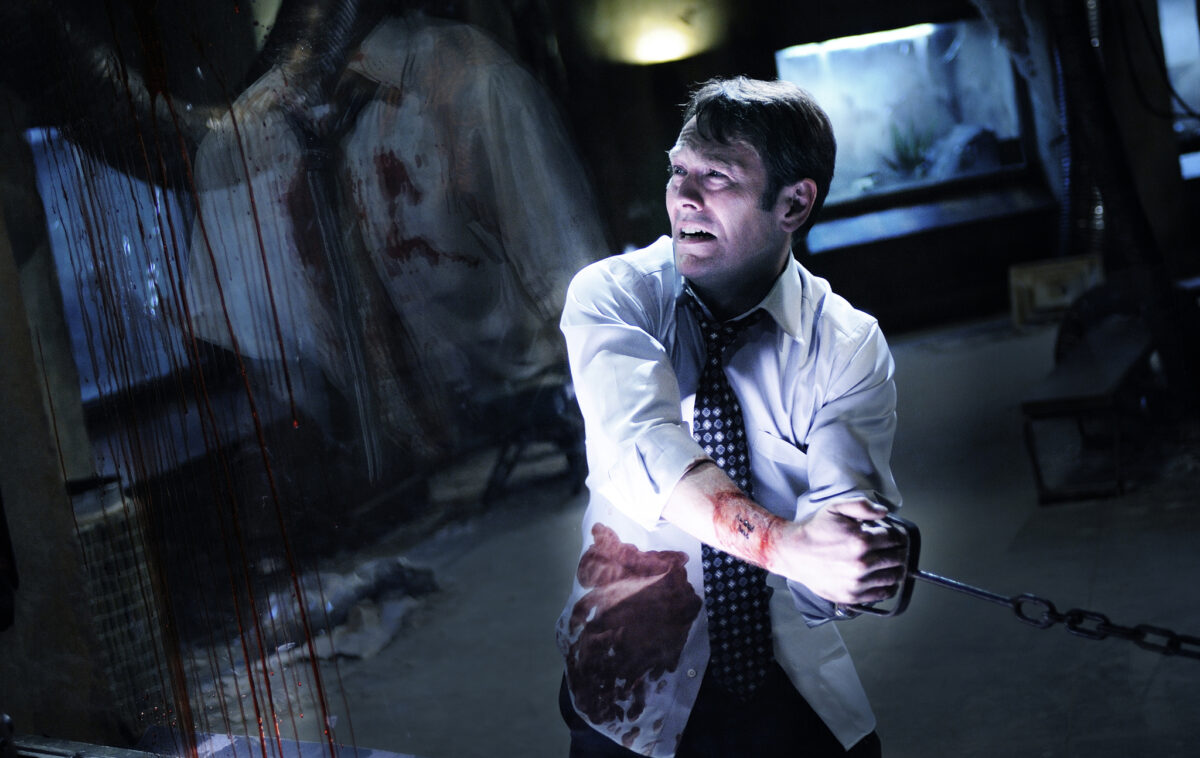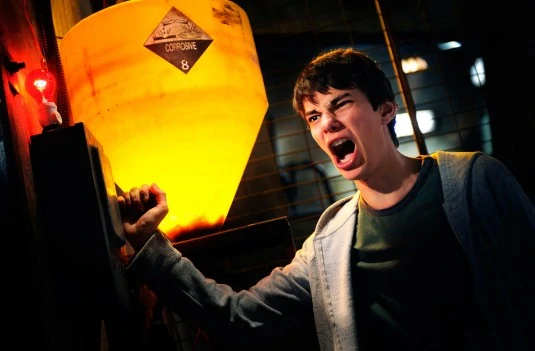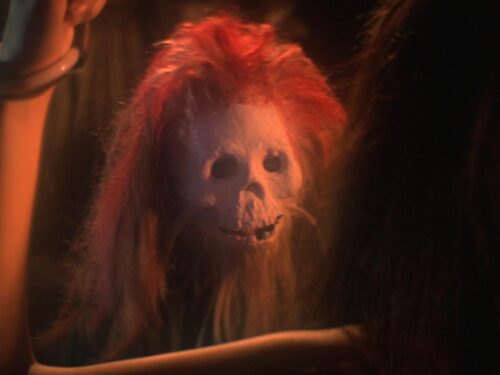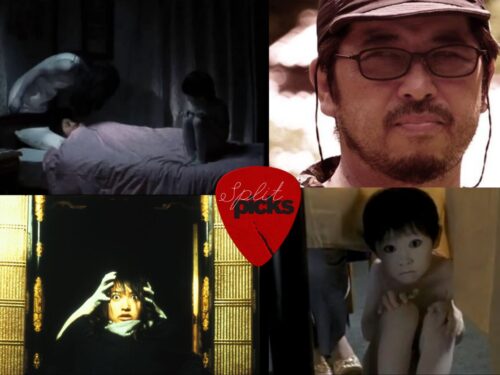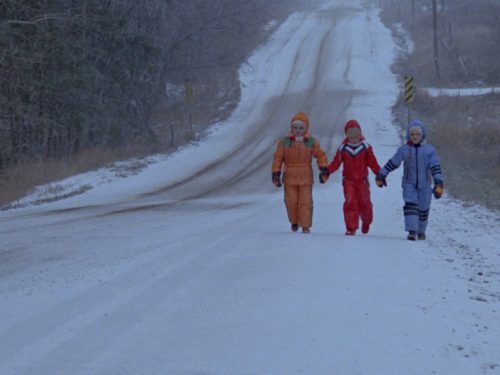The question of whether Jigsaw is pure evil is modified, questioned, and inverted through the Saw series. In Saw VI, Jigsaw takes on the injustice of the healthcare industry.
Nobody was more thoughtful or politically minded in describing the filmgoing public’s love-hate relationship with horror cinema than legendary Canadian critic Robin Wood. The most disreputable of genres, horror’s popularity and respectability, Wood argued, are inversely proportional. He fleshed out thoughts he first explored in Times Educational Supplement and mapped out a broad theory of the genre and its political taxonomy in his landmark “An Introduction to the American Horror Film.” On the genre’s unusual, paradoxical kind of popularity, he writes:
“It is restricted to aficionados and complemented by total rejection, people tending to go to horror films either obsessively or not at all. They are dismissed with contempt by the majority of reviewer-critics or simply ignored.”
It’s possible even he was taken aback by the bile directed at the Saw franchise during its brief heyday as a Halloween staple, coinciding with roughly the last half decade of his life. Here’s a film-by-film sampling of what some critics had to say about the initial Saw cycle:
- “Saw pushes the envelope on sadism, becoming so punishingly brutal that even this hardened horrorphile cried, ‘Hold! Enough!’ I think what finally got to me — even beyond the scene in which a little girl is tortured — was the lack of distance between the psycho and the filmmakers.” — David Edelstein, Slate
- “[Saw II] plays out as a sinister reality-TV show or an overly pious science experiment.” — Kevin Crust, L.A. Times
- “The inevitable deadening effects of repetition are beginning to infect the Saw franchise.” Frank Scheck, The Hollywood Reporter
- “Is making [Saw IV] impossible to follow a deliberate ploy to ensure DVD sales?” — Jamie Russell, BBC
- “While [Tobin] Bell has created one of the better horror villains in recent history, [Saw V star Costas] Mandylor isn’t much scarier than his Picket Fences character. It’s hard to see how the series is going anywhere but downhill as his screen time expands.”— Peter Hartlaub, San Francisco Chronicle
- “[Saw VI] features two or three scenes that actually feel complete.” — Wesley Morris, Boston Globe
- “Saw 3D is sicko-exploitative, viscera-spewing trash … The most disturbing thing about the Saw films is the way that they turn torture into a wink of megaplex vengeance. They’re made, and consumed, as a big bloody joke, and that’s scary.” — Owen Glieberman, Entertainment Weekly
Ready for a twist? Those critics were all positive on the series installment they’re discussing, at least according to the standards established by review aggregator Rotten Tomatoes. Jigsaw, it seems, put critics in a position somewhat like his victims, with a choice that isn’t much of a choice at all, leaving the film itself in bloody tatters no matter what. Sympathetic critics were always outnumbered and their qualified praise sounds downright laudatory compared to the average assessment of a Saw flick. Whether it was copious suffering, undercooked philosophizing, convoluted plotting, or just undistinguished filmmaking, critics found plenty to take issue with in each subsequent installment of the enduring franchise. Though it started as a word-of-mouth sensation at Sundance and would briefly hold the record for highest-grossing horror franchise, Saw was already the stuff of Scary Movie parody by the middle of its run. Even considering the long history of skepticism, backlash, and moral panic greeting horror cinema, the vitriol reserved for the seven proper Saw films was especially intense. Perhaps no series better exemplifies Wood’s arguments about horror’s position in the cultural imagination. To me, perhaps no single film problematizes his theories on the genre’s politics better than Saw VI (2009), the best installment in the franchise and undoubtedly one of the great under-appreciated horror films.
Like some franchise-starters before it — Halloween (1978) and Friday the 13th (1981) among them — Saw (2005) not only introduced an iconic new killer, but helped codify a soon-to-be-maligned new subgenre. Anyone who thought horror had reached its bloody nadir with the slashers of the ’80s or the post-modern imitators of the ’90s surely took part in the discourse around “torture porn.”1 Though the term was plainly meant as a dig and has never been embraced by genre fans or series filmmakers, it’s survived in the mainstream press. Attempted reboots Jigsaw and Spiral proved the term was still at the ready when they hit theaters to largely negative reviews in 2017 and, after pandemic delays, 2021, respectively. The first collection of criticism exploring the series, To See the Saw Movies, wears it in its subtitle: Essays on Torture Porn and Post-9/11 Horror. One particularly illustrative takedown, from the Winter 2009 issue of Cineaste, takes advantage of the phrase too. Throughout “The Problem of Saw: ‘Torture Porn’ and the Conservatism of Contemporary Horror FIlms” author Christopher Sharrett provides a potent articulation of mainstream attitudes toward the series before undercutting his own arguments through deviations from Wood’s established terms, misrepresentation of events in the series, and attempts to review Saw’s perceived audience.2
Trying to summarize the first six Saw films briefly and coherently won’t be painless; imagine I’ve slowly chipped away at a much more detailed synopsis. The series opens in an unnamed city, terrified of the Jigsaw Killer, who kidnaps his victims and places them in elaborate traps meant, he argues, to test their resolve and willingness to live. Sequels gradually reveal that Jigsaw is John Kramer (Tobin Bell), an engineer for whom an inoperable brain tumor, an unsuccessful suicide attempt, and a miscarriage have inspired a strange new lust for life. A typical Jigsaw “game” subjects the victim to a punishment that calls back to past transgressions with cruel irony and necessitates serious bodily harm. For example, Kramer’s very first game (revealed in Saw IV) forces the shackled Cecil (Billy Otis) to push his face through a gauntlet formed by eight criss-crossing knives in order to press a lever with his forehead, release himself, and walk away. Cecil, the man who caused Kramer’s wife, Jill Tuck (Betsy Russell) to miscarry, is among the more predictable Jigsaw targets. Murdering Cecil is a move right out of the revenge killer’s handbook, hacky stuff from a so-called mad genius.3 Otherwise, Jigsaw’s definition of the appropriate victim proves both morally inconsistent and, quite often, politically problematic. Drug addicts, in particular, play recurring roles and provide fodder for rants that’d find Kramer lots of friends among the GOP.4 Sharrett is right to recognize this fact. He still can’t resist overselling his points with invented characters. Here’s how he categorizes the unlucky test subjects of Saws I through VI:
“Negligent fathers, cheating husbands, drug-addicted kids, ‘career women’ who ignore their family duties and so on; the tests are for the purpose of teaching the true value of life.”
Among Jigsaw’s female victims are the requisite drug addicts, a sex trafficker, a corrupt housing official, a predatory lender, and a brain surgeon whose grief has led her to turn to both drugs and infidelity. In Saw VI, one woman is chosen precisely because of who her boss is. She is then, however, shown to be the exact opposite of the “career women” Sharrett describes. Likely, it’s a phrase he’s seen, heard, or invented from the Saw cycle’s fans — a group he categorically dismisses as unthinking, bloodthirsty cretins.
The most notable of the cycle’s “drug-addicted kids,” Amanda Young (Shawnee Smith) appears first in Saw as the lone survivor of Jigsaw’s twisted games. We soon learn that “Jigsaw” has come to mean Amanda Young as much as it means John Kramer. She’s both an accomplice and a cultish acolyte, willing to suffer through traps to maintain her cover and serve Kramer’s wishes. Neither one makes it out of Saw III alive. All the while, a series of (mostly doomed) detectives is investigating the murders and wondering how a cancer-stricken man is managing to pull it all off. It turns out he had yet another accomplice in Detective Mark Hoffman (Costas Mandylor). Saw V (2008) exists largely to explain, via both flashback and rival Detective Peter Strahm (Scott Patterson)’s stunned observations, how Hoffman went from opportunistic Jigsaw imitator to favorite acolyte. As Saw VI begins, Hoffman has evaded Strahm and begun to frame him for the Jigsaw killings. He continues throughout the film to cover his tracks and appear impossibly suspicious in every conversation with his co-workers on the police force. Flashbacks depict both the kind of sibling rivalry between Hoffman and Young and, more interestingly, Kramer’s unsuccessful attempts to secure health insurance coverage for experimental cancer treatments.
Though Wood clearly provides a general framework for Sharrett and both critics share disdain for slashers and disappointment over the death of 1960s revolutionary idealism, they seem to diverge on the subject of the “apocalyptic film” and its potential radical implications. While acknowledging that it’s easy to confuse reactionary and apocalyptic films, Wood draws a key distinction between the two, making it clear that the negation inherent to apocalyptic films is, in many of the genre’s best examples, ultimately progressive. Likening the Saw films to Se7en (among their clearest influences), Sharrett suggests they’re all, “instructive principally as a compromised index of an apocalypticism rampant in our culture.” His clear disregard for all the films in question implies that he, unlike Wood, considers apocalypticism more or less synonymous with nihilism, if not outright Conservatism. Few mainstream films reach the depths of nihilism that each Saw film plumbs. All but one ends with a doomed character screaming over the end credits; V only ends differently because the character’s been crushed to death. The series’ darkness is enough to overpower the traditional forces whose moral authority typically defines reactionary cinema of all genres: the police force is categorically hapless or corrupt; the Church is completely non-existent. Though Kramer’s grievances include right-wing talking points like addiction and the loss of a pregnancy, it’d be a stretch to call his ideology coherent, let alone give it a name. Even the grudging (or not so grudging) affection Sharrett observes in Saw’s creators conflicts with Wood’s criteria for a purely reactionary horror film. Whatever we’re meant to make of Kramer, his acolytes, and their dubious morals, the question of whether Jigsaw is pure evil is modified, questioned, and inverted from the very start. Worst of all, Sharett ignores (perhaps deliberately) the events of Saw VI, a film which sees Kramer make arguments against private health insurance that would qualify as radical by the definitions established in mainstream politics and media.5
Sharrett’s refusal to discuss Saw VI calls to mind reactions to Bernie Sanders’ 2019 appearance on The Joe Rogan Experience. To many, Rogan’s very presence at the table and deservedly poor reputation invalidated the subsequent conversation — if not the entire Sanders campaign. Despite the evidence presented throughout Saw VI, Sharrett seems to have let a title and his perceptions of the intended audience encourage him to dismiss the actual text out of hand:
“The Saw franchise is another of the postmodern cinema’s examples of a vacuous critique of capitalist society from a decidedly conservative position … suggests capitalist culture as a ‘fallen world’ at the end of its road — for vaguely moral rather than political and economic reasons.”
In Saw VI the reasons are, in fact, explicitly political and economic as well as moral. For the first and only time in the series, a news landscape is shown to exist outside the scope of Jigsaw’s crimes. Politicians on television discuss what we can only assume are the same issues facing the film’s real-life audiences. After trying and failing to convince Umbrella Health executive William Easton (Peter Outerbridge) to grant coverage for experimental treatment, Kramer gestures toward the television and says what we’re all thinking:
“These politicians, they say the same thing over and over and over again. ‘Healthcare decisions should be made by doctors and their patients, not by the government.’ Well, now I know they’re not made by doctors and their patients, or by the government. They’re made by the fuckin’ insurance companies.”
Is this an especially sophisticated argument? No, but it’s a far cry from the “bogus moralizing” Sharrett and countless series detractors took issue with. Sharrett makes Jigsaw out to be a Conservative avatar, citing especially his insistence on the primacy of personal choice and the possibility of lifting oneself out of misery (or away from certain death) through sheer determination. Nowhere is the notion of personal choice made into a crueler joke than across the private health insurance industry. If the film is shotgun-subtle in delivering that critique then it’s no different than any number of didactic films and television shows that are today credited with elevating their genres through dialogue just like this. Even this sequence resists pure didacticism with a strange aside from Jigsaw, ensuring, in Wood’s words, “the film’s sense of fundamental horror is closely allied to a sense of the fundamentally absurd.” Seemingly caught in a reverie, Kramer fixes his eyes on Easton’s fish tank and brings the sequence to a halt by commenting, “Piranha.” Wood singles out The Texas Chain Saw Massacre (1974) for its deft blend of the horrible and the absurd, but Saw VI looks more like Tobe Hooper’s outlandish Part II (1986). In addition to toying with audience expectations about what their franchises ought to entail, both films benefit from juxtaposing their characters against a recognizably real world. It makes an odd kind of sense that the cannibalistic Sawyers would find fame and fortune in the world of rapacious Reagan capitalism and that Jigsaw’s games fit right into a world that’d nurture private health insurance.
Kramer isn’t the first person we see denied coverage in Saw VI. In fact, this episode in Kramer’s relationship with Easton and Umbrella Health comes late in the film. We’re introduced to Easton much earlier, immediately after watching Detective Hoffman clean up the aftermath of Saw V. It’s clear at once that he’s Jigsaw’s next playmate. The first words out of his mouth are to break plans and he’s soon dismissing questions about legal trouble while touting the pure objectivity of his heartless approach to his work. A flashback shows how Harold Abbott (George Newbern)’s policy was terminated as a result of a dubious preexisting condition. “You just killed me,” he says, and by the time we’ve met Easton in the present day, Abbott is already dead. His family are the ones suing Umbrella. Unfazed, Easton expresses his pride in all the good work his organization does — including sponsoring Tuck’s clinic — as well as the ruthless discrepancy-spotting prowess of his “Dog Pit.” Easton’s six lackeys sit at a round table outside his office engaging in back-slapping back and forths while greeting their boss with almost childish deference. One of Easton’s “Dogs” (Darius McCrary, Eddie Winslow from Family Matters) proudly shows “Mr. E” how he found $200,000 in potential savings like he’s bringing home a report card. If it’s not a subtle evocation of insipid corporate villainy, it’s most definitely an accurate one. A largely humorless series6 finds plenty to laugh at here. Where a reactionary film might frame this office camaraderie as aspirational, Saw VI lays out material for justifiable ridicule while marking everyone for certain death. The withering glance that Easton’s janitor, Hank, shares with the camera after a faux-genial slap on the back not only telegraphs his significance to the narrative ahead, but mirrors the audience.
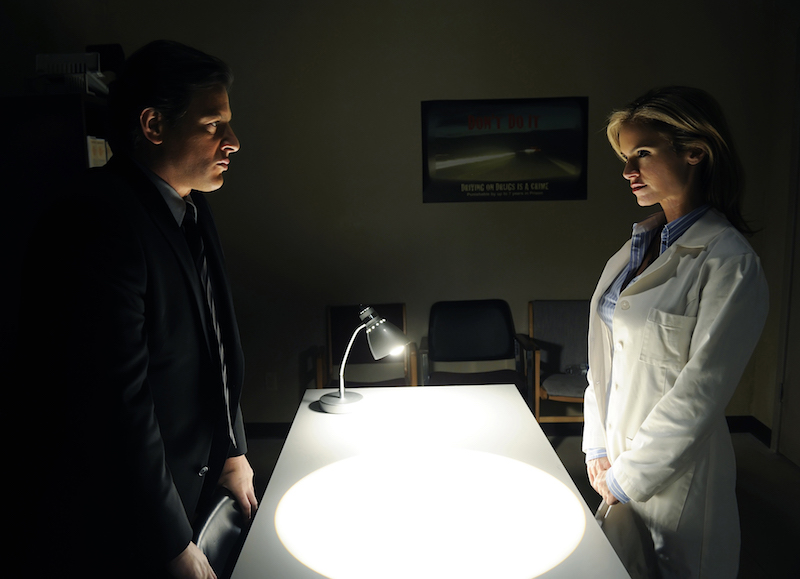
Despite the series’ notoriety for pouring on the guts and goop with more and more extreme torture apparatuses, Easton’s first game is simple enough that viewers can play along at home. One of the most evocative sequences in the series injects a reckless sense of momentum despite the conspicuous lack of a ticking clock. Most of Jigsaw’s traps have cacophonous soundscapes, mechanical sounds mingling with screams and the occasional non-diegetic track. This one is effectively silent save for the inconsistent sound of breathing. Easton and Hank are restrained side by side with shackles on their limbs and vises closed around their ribs. Each breath they draw closes the vise and tightens the grip on their bones. The experience, we learn, is meant to test how committed Easton is to the formulas and policies that help him callously make life-or-death decisions every day. Hank is a long-time smoker, which makes him unworthy of life in Easton’s typical professional opinion.
Additional flashbacks take us to an event at Tuck’s clinic and a conversation between Kramer and Easton. After Easton outlines the simple mathematical formula behind Umbrella’s policy decisions, Kramer remarks in his usual portentous terms, “In a sense, you choose who lives and dies.” As Easton makes his way through an abandoned zoo, the traps to come force him to make this decision face to face with those affected. More than one unlucky participant shouts, “look at me,” as Easton condemns them. Meanwhile, Pamela Jenkins (Samantha Lemole), a journalist on the Jigsaw beat, and Tara (Shauna MacDonald) and Brent (Devon Bostick) — a mother and son who feel certain the family patriarch is to blame for their predicament — watch Easton’s progress on closed-circuit TVs. They can see each other’s cells, but not each other. Both cells are equipped with huge tanks of hydrofluoric acid. Perhaps the highlight of the entire series, Easton’s fourth and final “minigame” involves his full team of work subordinates. Arranged on a playground carousel, each “Dog” has their hands tied behind their back as they spin before a stationary shotgun. Easton can save two of them if he’s willing to choose and let metal rods pierce through both his hands. Who Easton chooses to save is unimportant compared to what their fight for survival reveals about them. Like any co-workers pitted against one another, they resort to pettiness and personal remarks instantaneously as they strive to determine whether appealing to sympathy or “the policy” will serve them better. Among the last words of the sequence’s last victim: “Your policy is bullshit!”
Sharrett accuses post-Reagan horror cinema of devolving into an “archetypal thrill ride” and the Saw cycle is a cinematic carnival if ever there was one. Appearing at the same time each year for its stomach-turning limited engagement, the series nevertheless distinguished itself from other franchises through an uncommon mix of routine and reinvention. With just a year between installments, the carnies behind Saw were forced to construct nightmare worlds from a combination of new attractions and recontextualized familiar ones. It’s normal for horror franchises to rely on twists as they progress into later sequels. Generally, this means a novel new setting. At most, viewers can expect the shocking revelation that somebody’s related to the killer. Saw and its sequels generally forgo the usual archetypal thrills, or put such an unusual spin on them as to make shopworn story beats completely disarming. Throughout its run, the series establishes and subverts its own archetypes again and again. Viewed in sequence for the first time, it invites and insists upon an investigative style of viewing, training us to look for characters who’ll reappear and lines that’ll turn out to be warnings or clues. It’s a style of storytelling that’s detestable when self-styled intellectual filmmakers deal in it and thrilling when a franchise with Saw’s reputation does. Any fan of the series knows that much more than an exercise in escalating depravity, the Saw series is an exercise in escalating narrative complexity and moral incoherence. The first five films alone include not just an abundance of twists, but an abundance of types of twists, such as:
- Twists related to character’s fates: Detective Matthews (Donnie Wahlberg) survived Saw II and is now a trap participant in Saw IV.
- Twists related to character’s motivations: Both Amanda Young and Detective Hoffman are Jigsaw acolytes, revealed in flashback to have contrived some of the traps we’ve seen.
- Twists related to character’s relationships: Dr. Lynn Denlon (Bahar Soomekh) and Jeff (Angus McFadyen), seemingly unrelated Saw III victims, are married.
- Twists related to an individual film’s timeline: The events inside Saw II’s “nerve gas house” occurred prior to the rest of the film.
- Twists related to the continuity between films: Saw III and Saw IV occurred concurrently.
- Twists related to the nature of a game: Every participant in Saw V’s central game was meant to survive, if only they had worked together.
By my count that’s almost as many types of twists as the original series has installments. Take into account that most of the above bullets are represented more than once and you’ve got a series that’s built to confound coherent readings. Sharrett acknowledges from his opening paragraphs that studying The Book of Saw may not prove a worthwhile endeavor. Like so many participants in Jigsaw’s games, he’s painfully close to being right. If your aim is to place Jigsaw definitively on the political spectrum, you’re bound to fail. Though Sharrett calls the killer’s morals “rigid,” they’re really anything but, constantly taking new shapes to suit the particulars of any given game or franchise installment. The films are, as Sharrett says, “symptomatic,” just not in the way he thinks they are. Unaware of the other James Wan-spawned horror franchises to come, Sharrett dismisses the Saw cycle as purely a symptom of the genre’s subsumption by market forces. He champions George A. Romero’s Land of the Dead and Diary of the Dead, the “Masters of Horror” TV series, and Alexandre Aja’s remake of The Hills Have Eyes as competent reflections on the Bush era, but can’t bring himself to do the same for any of the Saws, not even VI. They are not merely regressive works expressing human worthlessness, but ruminations on pervasive feelings of worthlessness, helplessness, and directionlessness. The cycle’s unsummarizable plot and unclassifiable stance on its central killer are not just symptoms of its commercial goals, but of the specific milieu that generated it.
Just when you thought the franchise had exhausted the possibilities for last-minute revelations about the nature of its central traps, Easton sees a wall marked with a red arrow and one word: Family. We immediately learn that Jenkins wasn’t kidnapped for her too-probing interest in Jigsaw. Rather, she’s become a player in Saw VI’s game because her brother denied Jigsaw health care coverage. That wasn’t his wife he was blowing off when we first met him; Easton’s sister is the “only family [he] has.” Tara and Brent, it turns out, are not at all who conventional cinematic language has led us to believe; of course they’re not. Saw has always relied on conventions and logic all its own. When Tara says “we’re here because of your father,” she looks towards Easton’s image on the TV screen. Even fans who’ve learned the franchise’s every trick would be forgiven for getting fooled by that one. They’re actually Abbott’s wife and son and it’s been their game all along. After watching Easton make his way through the zoo and reconsider the wisdom of his policy, they’re asked to make a choice through a lever marked “live” and “die.” It’s not a terribly difficult choice; Brent pulls the lever and injects Easton’s body with hydrofluoric acid. Seeing Easton melt from the inside out, probably the series’ most gruesome execution yet, provokes a fittingly paradoxical mix of emotions. Any catharsis found in watching a stand-in for the health insurance industry die is complicated by Jenkins’ presence and by knowing how gamely Easton has participated throughout the film. One senses he’s probably learned his lesson. What’s more representative of Jigsaw’s genre of morality than asking us to both luxuriate in suffering and feel kind of bad about it?
That VI was the lowest-grossing entry in the series indicates perhaps Sharrett wasn’t alone in balking at the concept of a socially conscious Saw movie. It’s also an irony befitting horror’s unpopular brand of popularity that the best of the cycle’s films would prove its least successful. Had Sharett waited until after Saw VII, he might’ve been right in taking the series to task for living in its central killer’s thrall. Saw VI features perhaps the most surprising twist of the series, surprising in the sense that it’s a twist at Jigsaw’s expense. Working in secret, Hoffman manages to derail Kramer’s patronizing, faux-religious mission to rehabilitate Young.7 If Young’s role in Jill’s miscarriage tacitly implies Kramer is correct about addicts being irredeemably bad, his ignorance to the facts simultaneously calls into question his entire worldview and challenges his omniscience. The closest thing the franchise’s fallen world has had to a God has not, Saw VI seems to conclude, planned for everything. It’s no wonder subsequent twists would go on to reassert Kramer’s dominance and allow him to continue directing the action from beyond the grave. Per Wood’s characterization of the horror film, what had been repressed (Jigsaw’s genius) necessarily had to return.
In an essay for Cineaste’s Spring 2021 edition, Sharrett celebrates the ongoing victory of New Horror Cinema, characterized by “intelligence,” over the “‘Torture porn’ and uninspired frachises” that comprised the genre’s output back in 2009. The supposedly revolutionary films Sharrett singles out (you’ve probably seen them) have all been discussed more than enough and aren’t worth mentioning here. What is worth reflecting on is Sharrett’s brief discussion of The Purge franchise. Sharrett offers minimal back-handed praise using terminology reminiscent of his previous dismissal of Saw. The films, he writes, “may be important chiefly at the symptomatic level as a comment on our social and political disintegration.” Though their exploitative content, he argues, undermines their class-conscious messaging, the escalating violence over four sequels isn’t enough to make him question whether the film industry is yet again choking out his beloved genre. He credits The Purge series with developing a clear aesthetic and, in 2018’s The First Purge, presenting a clear explanation for its high-concept premise. The Purge’s chronology may be easier to trace and its violence may look closer to something you’ve seen on the news, but even more than a decade removed from their era of ubiquity, the Saw films achieve a more vivid and more authentic evocation of living through an apocalypse that hasn’t offered the comforts of leaders with coherent politics, hope for the future, or life-saving choices worth making.
Stream Saw VI on Amazon Prime
Purchase Saw VI from Amazon
Stay up to date with all things Split Tooth Media and follow Bennett on Letterboxd
(Split Tooth may earn a commission from purchases made through affiliate links on our site.)
Find the complete October Horror 2022 series here:
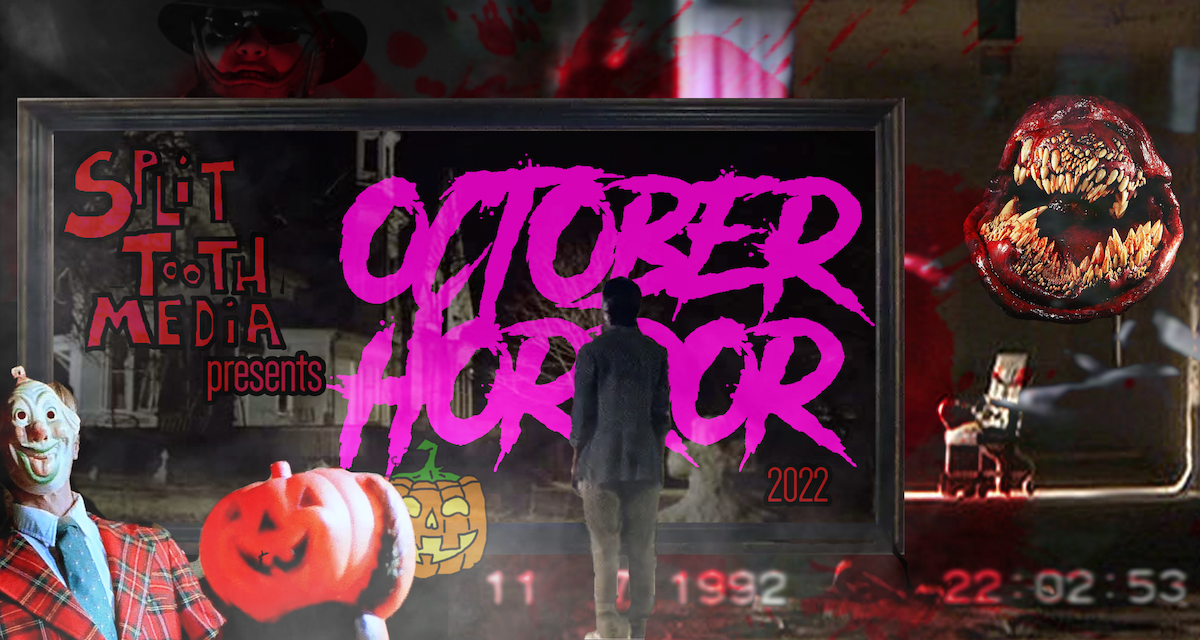
- The term has proven resonant, but David Edelstein’s essay introducing it to describe a loose subgenre (including, alongside the Saw movies, Wolf Creek, Hostel, and The Passion of the Christ), is at times wildly dated. Attempting to diagnose audiences’ thirst for vicious nihilism, he writes, “In the same way that some women cut themselves (they say) to feel something, maybe some moviegoers need to identify with people being cut to feel something, too.” Yikes! Edelstein was, years later, briefly infamous in certain circles for his drooling review of Wonder Woman. His defense of that review proudly cites this earlier essay.
- Even Wood can’t avoid briefly stooping to this level. He describes a “terrifying” experience watching The Texas Chainsaw Massacre with a youthful, cheering audience and resolves not to let such displays represent “the last word” on the genre and its appeal.
- Pearl-clutching skeptics like Sharrett abhor the series in part because they worry the people making and consuming the films admire Jigsaw a little too much. “The Internet,” as Sharrett writes, “is clotted with mindless palaver about the supposed moral virtues of the cycle’s monstrous protagonist.” Kramer’s free use of asinine puns (“your son is in a ‘safe’ place” and “careful, ‘hair trigger’” among them) tells you all you need to know about how seriously we ought to take most of his soliloquies.
- Speaking to Hoffman in Saw V, Kramer describes the rare survivors of his games as “rehabilitated.” The term, it should be noted, carries a penal connotation as well as a medical one.
- If it sounds like I’m giving the movie and the people who made it too much credit for what’s ultimately a pretty surface-level critique of insurance industry treachery, consider that “health insurance industry = bad” is a significantly more nuanced take than nearly every member of Congress could offer if pressed. Hell, literally getting pressed in one of Jigsaw’s traps might not be enough to inspire even that.
- I say ‘largely’ for a reason. No, really. No series with so many outlandish twists (not to mention the aforementioned puns) can be completely self-serious. During the flashback that opens Saw VI, you’ll even notice that Detective Hoffman taunts Detective Strohm with a slight ‘Nu Metal head tilt’ as he’s lowered to safety.
- Consider this footnote a cutaway: Hoffman learns that Young was with Cecil the night he attempted to rob the clinic and wound up causing Jill’s miscarriage. Through flashbacks, we discover that he was blackmailing her with this information and subjecting her to another test throughout Saw III. While Kramer was testing her by asking that she not kill Dr. Denlon, Hoffman was testing her by insisting that she pull the trigger.

